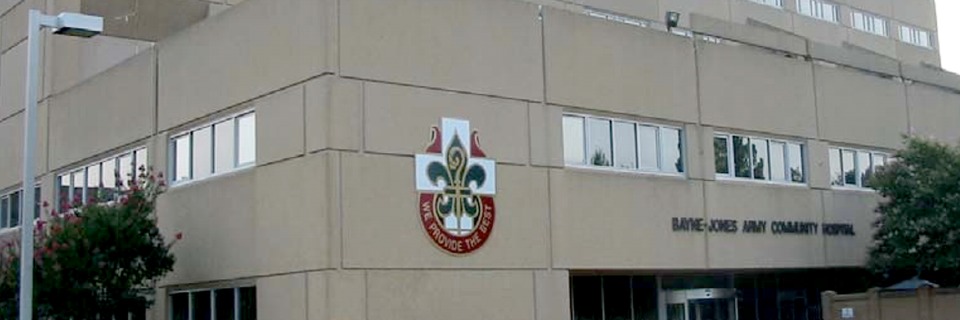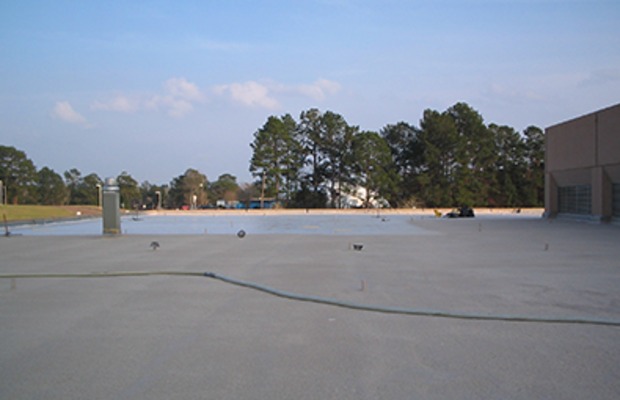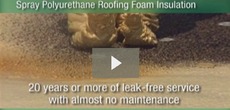
Bayne-Jones Army Community Hospital
The WWII army hospital in Louisiana is outfitted with a new spray-applied polyurethane foam (SPF) roofing system
The Fort Polk army base in Louisiana was built during World War II as a home base for training soldiers to fight the overseas war. Today, Fort Polk is an elite training ground called the Joint Readiness Training Center, where soldiers come to live and train in a highly realistic conflict environment.1
The base is now 65 years old and is currently undergoing one of the biggest construction booms in its history, with over $300 million in new construction and renovation projects ongoing.2 As part of this Fort Polk transformation, one of the base's main arteries, its hospital, received a new spray-applied polyurethane foam (SPF) roofing system in 2004. The re-roofing project was part of a partnership between Arizona State University's (ASU) Performance Based Studies Research Group (PBSRG) and the US Army to test PBSRG's Performance Information Procurement System (PIPS) process on three renovation projects throughout the United States.3
SPF roofing was an ideal choice for the Bayne-Jones Army Community Hospital, because of its low-disruption application methods and its ability to cover an uneven roof surface—like that left by the removed concrete footings—smoothly and seamlessly.
The PBSRG is a non-profit research group created to increase the level of performance in the construction industry. Dr. Dean Kashiwagi developed PBSRG in 1994 at Arizona State University's Del E. Webb School of Construction. PIPS is a PBSRG system designed to assist owners in selecting best-value contractors based on performance information rather than the traditional selection method of awarding construction contracts based on the lowest-cost bid.
The Bayne-Jones Army Community Hospital project at Fort Polk was a challenge in several regards. First, it is a full-service hospital with active operating and delivery rooms, serving a population of over 130,0004 Fort Polk residents and staff. This meant there had to be minimal disruption to the function of the hospital. Second, its 125,000 square-foot roof, made up of built-up roofing (BUR) over concrete, had many fresh air intakes that had to be diligently protected from the odors and fumes associated with a construction project. Finally, the existing roof had sections covered with 3 x 12-foot concrete footings supporting damaged and unusable solar collection units. These units, it was determined, would have to be removed and the spaces they left filled in. The Army made it clear they wanted an affordable, long-lasting and proven-performance roofing system to replace the entire existing roof structure.5
The partnership between the PBSRG and the US Army's Medical Command (Medcom) had established the Army's awareness of the PBSRG-created ALPHA performance contracting system and spray-applied polyurethane foam roofing. The ALPHA program is a tool for owners and contractors alike that gathers information on contractor performance. Currently, SPF roofing systems with urethane coatings are the only systems to qualify under ALPHA's stringent quality standards. Contractors must meet several criteria, designed to present a comprehensive picture of field performance, to qualify as ALPHA-certified contractors. These include:
- Annually submitting installed roofs over 5,000 square-feet
- Inspecting at least 50 non-ALPHA or 10 ALPHA-like roofs biennially using an independent third party
- Ensuring that 98 percent of roofs do not leak
- Ensuring that 98 percent of owners are satisfied
- Attending an educational presentation at ASU once a year
A site investigation of the hospital was conducted and, using the PBSRG tools, Medcom made their decision to go with ALPHA-rated contractor Insulated Roofing Contractors (IRC), and the specially engineered ELASTOSPRAY® ALPHA SPF roofing system from BASF. Dr. Dean Kashiwagi says the decision was made based on performance and price.
"The PIPS process identified IRC and the ALPHA system as the top performing system for the application, based on IRC's past proven performance information and the past performance information submitted for the ALPHA system," he said.
The IRC bid was not the lowest bid, stressed IRC executive Sean Stumler; the company was chosen for its high customer service score and high warranty score under ALPHA.
Stumler says the SPF roofing was an ideal choice for the Bayne-Jones Army Community Hospital, because of its low-disruption application methods and its ability to cover an uneven roof surface—like that left by the removed concrete footings—smoothly and seamlessly.
"We applied an inch and half of ELASTOSPRAY polyurethane foam and the Neogard Urethane Coating," explains Stumler. When asked if the building's function as a hospital provided an extra challenge, he says, "The minimal disruption of an SPF application was key in keeping the facility functioning normally. A different system may have required the BUR and concrete roofing to be removed, which would have caused significant disruption."
The now-obvious question in regard to any building in Louisiana is how it might stand up to severe weather. While Hurricane Katrina was not a factor for the Fort Polk Base due to its more northerly location, Hurricane Rita affected the area directly. The new SPF roofing did its job just like it should, says Stumler, and didn't budge an inch or leak a drop.
"We went down and inspected the roof after Hurricane Rita," says Stumler. "There was no wind damage at all. It performed perfectly."
1 About the JRC: http://www.jrtc-polk.army.mil/aboutjrtc.htm
2 About Fort Polk: http://www.jrtc-polk.army.mil/aboutpolk.htm
3 US Army Medical Command: Fort Polk http://www.eas.asu.edu/pbsrg/pips/current/usmedcom/usmedcom.htm
4 Fort Polk Fact Sheet: http://www.jrtc-polk.army.mil/FactSheet.pdf
5 Site Investigation Report: http://www.eas.asu.edu/pbsrg/pips/current/usmedcom/pilots/fortpolk/Me












